Chlorastrolite (Green Starstone)
Chlorastrolite, also known as the “Green Starstone” or “Michigan Greenstone,” is a rare and distinctive variety of the mineral pumpellyite, a silicate mineral. What sets chlorastrolite apart from other minerals is its unique green color and characteristic starburst or turtleback pattern.
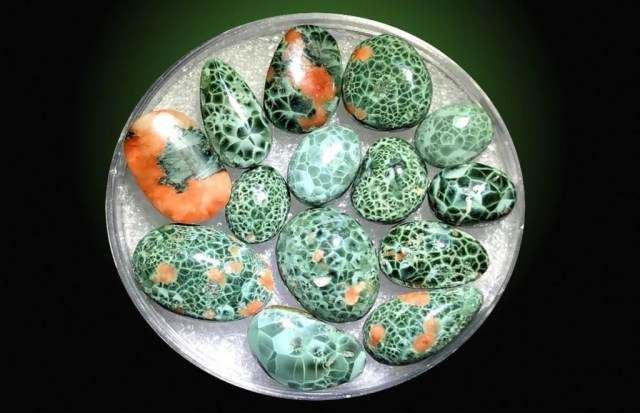
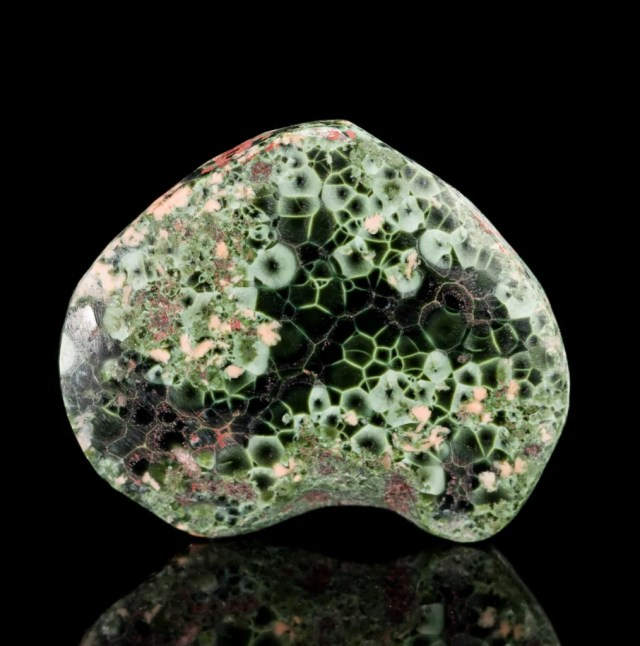
Green Color: Chlorastrolite gets its name from its striking green color. It typically ranges from a deep, earthy green to a lighter, more vibrant hue. The green color is often described as reminiscent of the lush foliage found in forests. This distinct color is a result of the presence of minerals such as chromium, iron, and other trace elements within the chlorastrolite’s chemical composition.
Starburst Pattern: One of the most remarkable features of chlorastrolite is its starburst or turtleback pattern. When the mineral is cut and polished, it often displays a radiating, star-like pattern with dark, concentric lines extending outward from a central point. This pattern can resemble the growth rings of a tree, leading to its nickname “turtleback” due to the appearance of a turtle’s shell. The formation of this pattern is thought to be the result of mineral growth over time, with concentric layers developing as the chlorastrolite crystallizes.
Chlorastrolite is relatively rare and has a limited geographic distribution. It is primarily found in the Lake Superior region of North America, with notable deposits in Michigan’s Upper Peninsula. Due to its unique appearance and limited availability, chlorastrolite has become a sought-after collector’s item and is often used in the creation of distinctive jewelry and ornaments.
The beauty and rarity of chlorastrolite, with its captivating green color and remarkable starburst pattern, make it a prized and treasured gem among both mineral enthusiasts and those seeking unique and eye-catching gemstones.
Contents
- Geological Formation of Chlorastrolite
- Physical and Chemical Characteristics of Chlorastrolite
- Occurrence and Distribution
- Uses and Applications of Chlorastrolite
- Rarity and Value
Geological Formation of Chlorastrolite
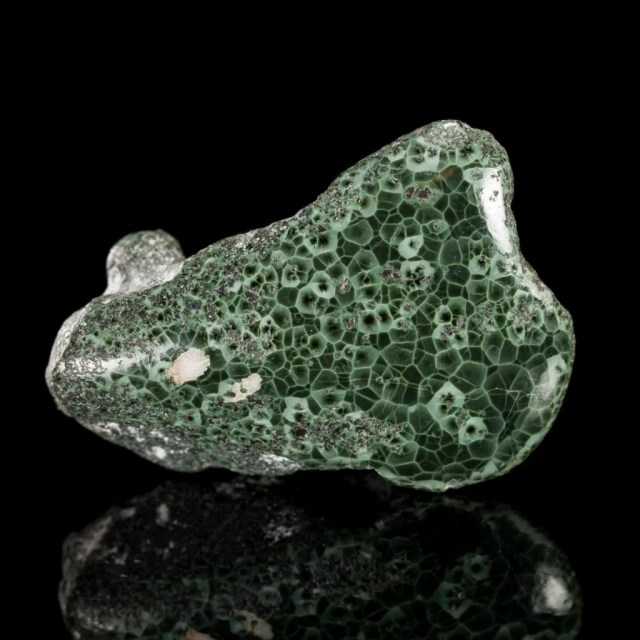
Chlorastrolite is formed through geological processes that occur in specific environments, often associated with metamorphic and igneous activity. Here’s a closer look at how and where chlorastrolite is typically formed:
Metamorphic Formation: Chlorastrolite is primarily associated with metamorphic rocks. It forms within pre-existing rocks that undergo significant changes in temperature and pressure. The original minerals within these rocks, which can include basalt, vesicular lava, and other volcanic rocks, undergo chemical and structural transformations due to these conditions. As a result, pumpellyite minerals present in the rock can recrystallize and transform into chlorastrolite.
Igneous Intrusions: Chlorastrolite can also be found in the vicinity of igneous intrusions. When molten rock (magma) forces its way into existing rock formations and cools underground, it can alter the surrounding rocks, potentially leading to the formation of chlorastrolite. The heat and mineral-rich fluids from the magma can trigger the alteration of pumpellyite minerals, promoting the growth of chlorastrolite.
Specific Locations: Chlorastrolite is most notably associated with the Lake Superior region of North America, particularly in Michigan’s Upper Peninsula. This area has a geological history that includes volcanic and metamorphic activity, which is conducive to the formation of chlorastrolite. The mineral is often found in association with other minerals, such as prehnite and datolite, in the rock formations of this region.
Mineral Alteration: The formation of chlorastrolite is linked to the alteration of pumpellyite minerals. Pumpellyite is a group of minerals that includes chlorastrolite, and this alteration process can be driven by various factors, including the introduction of fluids rich in elements like aluminum, iron, and chromium. These chemical reactions and mineral transformations can lead to the unique green color and starburst pattern that are characteristic of chlorastrolite.
Geological Time: The formation of chlorastrolite is a slow process that occurs over geological time scales, often millions of years. It requires the right combination of mineral composition, temperature, pressure, and fluid activity for chlorastrolite to develop within existing rocks.
In summary, chlorastrolite forms through the metamorphism and alteration of specific minerals in the presence of heat, pressure, and mineral-rich fluids. Its unique geological history in regions like the Lake Superior area has contributed to the formation of this distinctive and valuable mineral.
Physical and Chemical Characteristics of Chlorastrolite
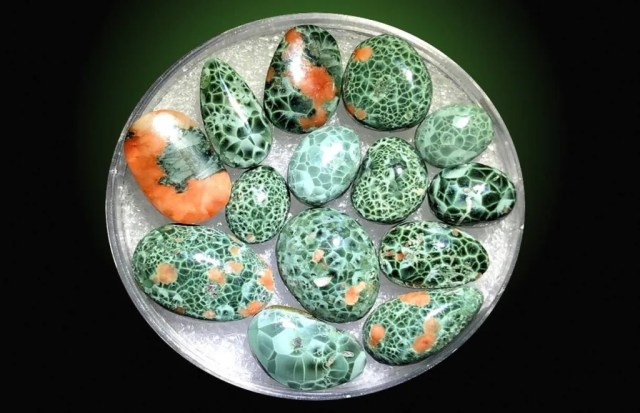
Chlorastrolite, the “Green Starstone,” possesses a set of physical and chemical characteristics that make it a distinctive and valuable mineral. Here are some key features:
Physical Characteristics:
- Color: Chlorastrolite is most renowned for its vivid green color. This color can vary from a deep, forest green to lighter, more vibrant shades. The green hue is a result of trace elements such as chromium and iron within its chemical composition.
- Luster: The mineral typically displays a vitreous or glassy luster when polished. This luster contributes to its aesthetic appeal and is highly valued in the creation of jewelry and decorative items.
- Transparency: Chlorastrolite can be either translucent or opaque, depending on the specific specimen. Translucent chlorastrolite allows some light to pass through, enhancing the visibility of its green color.
- Crystal System: Chlorastrolite crystallizes in the monoclinic crystal system. It forms prismatic crystals with a radiating, starburst pattern when cut and polished.
- Hardness: Chlorastrolite has a relatively low hardness of around 5.5 on the Mohs scale. This means it is susceptible to scratching and may require care when used in jewelry.
- Cleavage and Fracture: Chlorastrolite typically exhibits no distinct cleavage, but it can fracture conchoidally, resulting in smooth, curved fracture surfaces.
Chemical Characteristics:
- Chemical Composition: Chlorastrolite is a member of the pumpellyite mineral group and is primarily composed of hydrated calcium-aluminum silicate. Its chemical formula can be expressed as (Ca,Na)2(Mg,Fe)3Al2Si3O12(OH)4·2H2O. The specific mineralogical composition can vary, depending on the locality in which it is found.
- Green Coloration: The green color of chlorastrolite is attributed to the presence of trace elements, with chromium and iron being the most significant contributors. These elements are responsible for the vibrant green hues seen in chlorastrolite specimens.
- Specific Gravity: Chlorastrolite typically has a specific gravity ranging from 2.7 to 3.0. This value is a measure of its density in relation to the density of water.
- Alteration Mineral: Chlorastrolite often forms through the alteration of pre-existing minerals like pumpellyite. This alteration process involves the recrystallization of pumpellyite under specific geological conditions.
- Formation in Metamorphic and Igneous Settings: Chlorastrolite’s formation is closely linked to geological processes, particularly in metamorphic rocks and areas influenced by igneous intrusions. The alteration of minerals in the presence of heat, pressure, and mineral-rich fluids plays a critical role in its formation.
Chlorastrolite’s unique combination of physical and chemical characteristics, including its vibrant green color and distinctive starburst pattern, contributes to its desirability as a collector’s gem and in the creation of ornamental items and jewelry.
Occurrence and Distribution
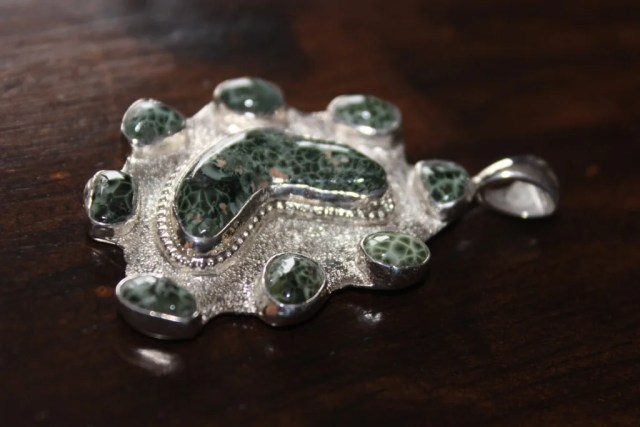
Chlorastrolite is a relatively rare mineral with a limited geographic distribution. It is primarily found in specific regions of North America, most notably in the Lake Superior area, and especially in Michigan’s Upper Peninsula. Here’s a closer look at its occurrence and distribution:
1. Lake Superior Region: The Lake Superior region, which encompasses parts of the United States and Canada, is the primary locality for chlorastrolite. Within this region, it is most commonly associated with the following areas:
- Michigan’s Upper Peninsula: This area is particularly renowned for its chlorastrolite deposits. The Keweenaw Peninsula and Isle Royale, both located in Michigan’s Upper Peninsula, are key locations where chlorastrolite can be found. The Keweenaw Peninsula, in particular, has long been associated with this unique mineral and is known for producing some of the finest specimens.
- Ontario, Canada: Some chlorastrolite occurrences have been reported in the Canadian province of Ontario, particularly in areas near Lake Superior. These Canadian deposits are less well-known than those in the United States.
2. Other Localities: While the Lake Superior region is the primary source of chlorastrolite, the mineral has also been reported in a few other localities, albeit less frequently. These include:
- New York: Chlorastrolite has been found in some parts of New York, although its occurrences there are less significant compared to the Lake Superior region.
- California: Isolated occurrences of chlorastrolite have been reported in California.
- Finland: Small occurrences of chlorastrolite have been documented in Finland, mainly in the region of Lapland.
3. Geological Formation: Chlorastrolite is closely associated with geological processes such as metamorphism and the alteration of pre-existing minerals. It forms in specific rock types, including basalt and vesicular lava, within the context of these geological activities. The alteration of pumpellyite minerals, which are members of the chlorastrolite group, plays a crucial role in the formation of chlorastrolite.
4. Rarity and Collectibility: The rarity of chlorastrolite, along with its unique green color and starburst pattern, contributes to its value as a collector’s item. Specimens of high quality and aesthetic appeal are highly sought after by mineral enthusiasts and collectors. As a result, chlorastrolite is often used in the creation of jewelry, cabochons, and ornamental items.
In summary, chlorastrolite is primarily found in the Lake Superior region of North America, with Michigan’s Upper Peninsula being the most famous and productive locality. It remains a prized and sought-after mineral due to its limited distribution and striking visual characteristics.
Uses and Applications of Chlorastrolite
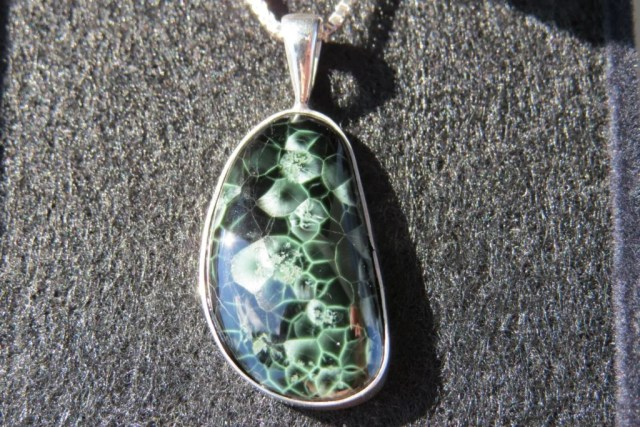
Chlorastrolite, with its unique green color and starburst pattern, is primarily valued for its aesthetic and ornamental qualities. Its uses and applications are predominantly in the realm of jewelry and decorative items. Here are the primary uses and applications of chlorastrolite:
- Jewelry: Chlorastrolite is often used in the creation of jewelry, including necklaces, pendants, earrings, rings, and bracelets. Its distinctive green color and starburst pattern make it an eye-catching and unique gemstone. Jewelry designers and collectors appreciate its rarity and visual appeal, and it is sometimes used as a centerpiece stone in custom pieces.
- Cabochons: Chlorastrolite is frequently cut and polished into cabochons, which are rounded, polished, and often domed gemstones without facets. These cabochons showcase the mineral’s characteristic starburst pattern, and they are used in jewelry settings, allowing the stone’s beauty to be fully appreciated.
- Ornamental Items: Chlorastrolite is also used in the creation of decorative and ornamental items, such as sculptures, carvings, and display pieces. Its unique appearance makes it an excellent choice for artistic and ornamental works, as it can add a touch of natural beauty and elegance to various art forms.
- Collector’s Items: Collectors of minerals and gemstones often seek out high-quality chlorastrolite specimens due to their rarity and distinctive characteristics. Specimens with excellent color, pattern, and overall aesthetics are prized and collected as valuable pieces.
- Lapidary Arts: Lapidarists may work with chlorastrolite to craft a variety of items, such as belt buckles, brooches, and beads, allowing its unique beauty to be incorporated into a wider range of artistic and functional creations.
It’s important to note that chlorastrolite is a relatively rare mineral, and high-quality specimens are not always easy to obtain. As a result, it is considered a valuable and collectible gemstone by both enthusiasts and professionals in the field of gemology and lapidary arts.
While chlorastrolite is primarily cherished for its aesthetic and ornamental qualities, it is not commonly used for industrial or scientific applications due to its limited availability. Instead, it remains a gemstone that is appreciated for its natural beauty and uniqueness.
Rarity and Value
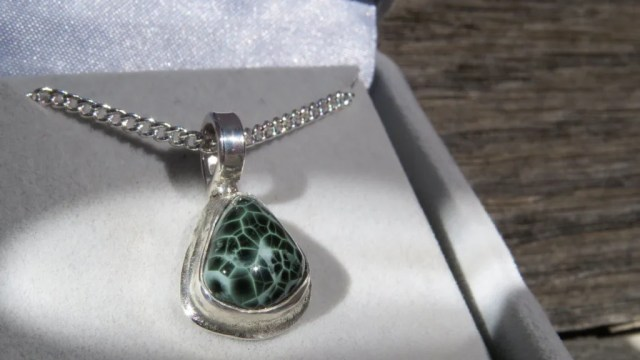
Chlorastrolite is considered rare and valuable due to its limited occurrence and distinctive visual characteristics. Several factors contribute to its rarity and value in the world of gemstones and minerals:
- Limited Geographic Distribution: Chlorastrolite is primarily found in specific regions of North America, with Michigan’s Upper Peninsula being the most renowned locality. The Lake Superior area, where chlorastrolite is primarily sourced, has a relatively small geographic footprint. This limited distribution contributes to its rarity.
- Unique Green Color: Chlorastrolite’s striking green color is one of its defining features. This color is the result of trace elements, such as chromium and iron, which give the mineral its distinctive hue. The vivid green, often likened to lush forest foliage, is highly sought after in the world of gemstones.
- Starburst Pattern: The starburst or turtleback pattern seen in chlorastrolite is another key factor that sets it apart from other gemstones. The radiating pattern resembles the growth rings of a tree or a turtle’s shell, adding to its visual appeal and collectibility.
- Aesthetic Appeal: Chlorastrolite is treasured for its aesthetic qualities. Its unique color and pattern make it a desirable gemstone for jewelry and ornamental items. High-quality chlorastrolite specimens with exceptional color and pattern command a premium in the market.
- Collector’s Item: Chlorastrolite’s rarity and distinctive appearance make it a prized mineral among collectors of gemstones and minerals. Collectors often seek out well-formed, high-quality chlorastrolite specimens for their private collections.
- Jewelry and Ornamental Use: The mineral’s use in jewelry and decorative items adds to its value. Chlorastrolite is often used in the creation of one-of-a-kind jewelry pieces, making it a unique and sought-after gem for designers and customers looking for distinctive, nature-inspired jewelry.
- Lapidary Craftsmanship: Skilled lapidarists can enhance the beauty of chlorastrolite through cutting and polishing, creating cabochons and other items that showcase its pattern and color. This craftsmanship can further elevate its value.
Chlorastrolite’s value can vary significantly depending on factors such as size, quality, color intensity, and the overall aesthetic appeal of the specimen. Larger, well-formed stones with intense green color and an attractive starburst pattern are typically more valuable. As with any gemstone, factors like rarity, beauty, and market demand contribute to its worth.
It’s important to note that the value of chlorastrolite, like other gemstones, is subject to market dynamics and the preferences of buyers and collectors. Additionally, the rarity and uniqueness of chlorastrolite make it a gemstone of particular interest to those who appreciate the beauty of Earth’s natural wonders.
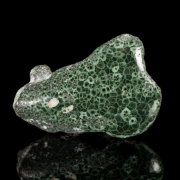


Leave a Reply
Want to join the discussion?Feel free to contribute!